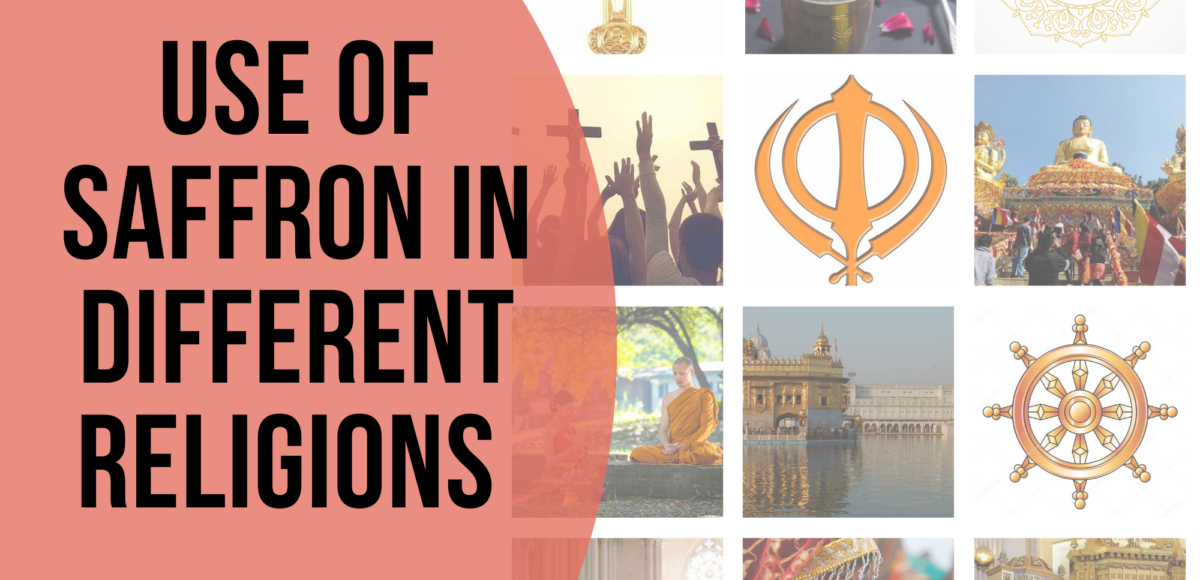
Use of Saffron in Different Religions
In the past, saffron has been used as an edible, a coloring agent, and as a perfume. Before long, many ancient cultures recognized not just the medicinal value of this wonder spice, but also the spiritual significance and saffron gained a respectable reputation in various religions of the world.
Let us explore the significance of saffron in different religions.
Hinduism
In the Hindu religious realm, saffron symbolizes Agni or the God of Fire. Agni, as a base element is held very sacred in Hinduism, signifying the life force that drives individuals to do things.
Based on the concept of color vibration therapy, the color of saffron strands and saffron dissolved in water helps to gain stamina and strength for the mentally weak people.
Mythological evidence points to saffron reverberating with Sandhya, which means sunrise and sunset. Here, Sun represents the energy of Fire in its divine, holistic power- the element that gives the world its energy but can also burn worldly desires. When a sadhu wears the color Saffron, it’s a representation of renouncement of worldly pleasures.
Saffron is used in the temple to perform various rituals such as poojas, Yagyaas, and Archana due to its ability to still the mind and provide purity. In Hinduism, a saffron paste is prepared and applied on the forehead as a “bindi or “tilak” of devotees as a mark of God’s blessing. Saffron can also help in the awakening of chakras. It energizes the Ajna or Third Eye Chakra: the pineal gland- which is further responsible for regulating all our other chakras and hormonal imbalances.
The Vedic texts identify putting “TILAK” of saffron on the forehead as an invitation to prosperity in life.
Buddhism
When Lord Buddha gave up his bodily abode, his body was kept inside of a mantle colored in saffron. The positivity that saffron dyed robes brought in Buddhism gained significance from thereon. To this day, Monks are seen dressed in either deep or lights hues of saffron!
Soon, the disciples discovered other uses of Red Gold and made it a part of their religious offerings and art: containing mandala signs that were actually painted with saffron color components.
In fact, according to history, Madhyantika, an Indian Buddhist monk, was the first person who planted saffron in Kashmir.
Christianity
Saffron is mentioned in the song of songs (4:14), as one of the most predominant aromatic spices, describing it as an adornment offered in the praise of The Lord. It surely makes one wonder how saffron was used in the religion, although its mention ensures that people were aware of what a priceless commodity this spice was!
Sikhism
The fierce religion, originating in Punjab and stemmed from deep love, accepts the deep bliss and joy of the color saffron. In Sikhism, saffron appears in the form of Nishan Sahibs, the Cholas worn by Sikh turbans, and Panj Pyaray, employing the power of absorbing shocks, trauma, and bad vibes. It is all about letting go that which holds us back and is not helpful. Saffron is known for connection, a sense of community and belongingness; and the social aspects of being: all that Sikhism also stands for!!
How is saffron used in other religions?
Islam, Christianity, and Judaism, the three Abrahamic religions, are not the only religions that wrote about saffron in their sacred texts.
There is no reference of saffron in the Quran, to begin with. But because of the later acquaintance of Muslims with Iran’s flora, the references to saffron and its various properties found their way into the many Islamic traditions (hadiths). In Hadiths, Islamic religious texts, the term “karkom” is written. Hadiths narrate that, during the pilgrimage, when one is faced with harsh climatic conditions and lack of sumptuous food, saffron can be used for its medicinal purposes as well as for better fragrance in food. Saffron can also be used for clothing as a dye but has not been a common practice in Islam.
In Persian literature of the Islamic period of India, there are also frequent references to saffron indicating its widespread use in India, especially among the Hindus.
The reference to saffron in the Old Testament shows that the Jews were familiar with it and, considering some passages of the Talmud, we can conclude that at the time the plant was being cultivated in surrounding lands!
Conclusion
Since ancient times, many uses of saffron have emerged for the different religions around the world. Saffron took its color significantly from fire and flames which stands for divine strength and purity. Symbolically, it promotes religions in moving forward with a life of simplicity, virtuousness, and penance. Modern science has only evidences that back up the possible potential of moderate consumption of saffron for preventive measures, and supervised use for its curative aspect.
Where would you find it?

Puri Brothers has a 7 decade old firm grip over the understanding and dealing with precious and worthy natural products, including saffron . We cater to our customers’ budgets and customize orders as per need. We come with the assurance of providing pure, laboratory tested products, ensuring long term association because of consumer satisfaction and product quality.
Do you have a requirement for Saffron? Reach out to us at +91 8146967058 or wecare@puribrosglobal.com.

Pingback: Saffron in the Kitchen - Puri Brother's Global
Pingback: How To Apply Saffron on Skin? - Puri Brother's Global